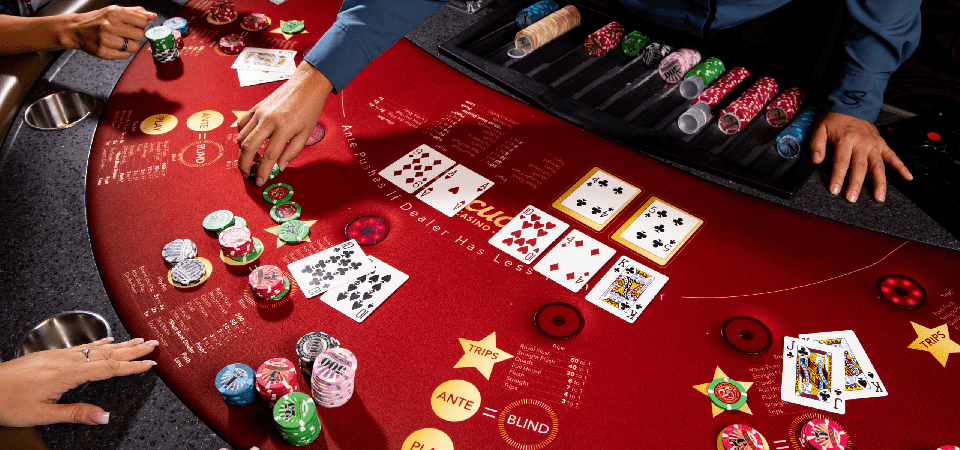
What Is a Straddle in Poker and How to Use the Bet Effectively
A straddle is an optional wager made in poker that is made prior to the deal. It enables a player to benefit from acting last prior to the flop. As a result, the player betrays the situation by doubling the enormous blind amount with an additional cash wager. Still, there are poker room rules that do not set a maximum amount for bets.
There are numerous variants in the rules that players straddle depending on. A player raises the stakes and obtains the big blind by making the voluntary blind bet.
In games where there are communal cards, like as Texas Hold 'em and Omaha Hold 'em, a straddle is the norm. Instead of acting first as is customary, it permits the player positioned immediately to the left of the blind to make the additional wager and act last. Players have to verbally place the straddle bet in accordance with poker regulations. Similarly, after viewing the cards, bettors are not permitted to declare the wager.
By acting as a voluntary third blind, the bet amount changes the game's limp-in level. In a Texas Hold 'em game with a $2.50 or $5 no-limit, for example, players can anticipate a $10 straddle. The next move is required by rules to call the $5 no-limit, raise, or fold.
A straddle modifies the minimum and maximum amounts for the game from $2.50 or $5 to $2.50, $5, or $10.
The straddler has the option to use their second action after examining the cards on the flop. Depending on the actions of other players, the player can select amongst three options: check, fold, or raise. Following that, the game continues normally with no additional impact on player movements or the playability of specific hand types.
Poker Straddle Types
distinct straddles have distinct rules that specify how to position yourself, how much to wager, and other possibilities. Card rooms interpret the rules in their own ways.
Here are a few popular versions of poker straddles:
Under-the-Gun Straddle (UTG) - In live cash games, this variation is well-liked by both players and casinos. A player seated to the left of the large blind can choose whether to straddle by placing a bet before to the dealer distributing the cards. The straddler finds it easier to steal the pot because he is the last player to act.
Button Straddle - Players can now straddle without having to sit in a specific posture thanks to the button. But the button straddle is open to the player who is positioned in the dealer's position. A player can cancel other straddles, such as the under-the-gun kind, by straddling with the button. Consequently, the wager is awarded to the UTG player.
Mississippi Straddle - Though it allows any player to put a straddle bet regardless of seating location, this kind of straddle is identical to the original kind. If no other player re-straddles (permitted by the rules), the straddler is the last to act.
Un-Capped Straddle - The amount that players can wager is unlimited while using the uncapped straddle. Players are able to wager their whole chip stack. However, considering the hazards involved in placing a significant wager, the decision needs to be well thought through.
Sleeper straddle - Sleeper straddles can be started by players from any location on the table. Even though certain card rooms have distinct rules, this variation is not a live straddle. When other players call or fold, the straddler remains in the standard position and forfeits the opportunity to raise.
Motives for Straddling
Because it affects the profitability of the game, players do not make the option to straddle lightly. Here are several useful justifications for straddling:
- Boost stakes in a lower-stakes game: Straddling is a viable option when opponents take a cautious approach, which turns the game into a lower-stakes affair. The straddle forces the opponents’ hands, thus raising the stakes.
- Get a chance to act last: Choosing to straddle enables a player to make a big raise if opponents call the straddle. When executed correctly, the strategy can be highly profitable.
- In the button: When rules allow a Mississippi straddle bet, straddling becomes a practical move for players in the button position. The tactic compels the blinds to fold if their hands are unfavorable. In turn, the straddler eliminates competition from the table.
How to Use the Straddle Bet Wisely
An effective straddle tactic allows a player to affect opponents' perceptions. By forcing rivals to often reimburse the straddler for their value bets, the strategy produces the intended effects. It makes sense that a lot of pros use straddles in poker tournaments, such the World Series of Poker (WSOP).
In order to optimize the win rate, players must to think about altering their pre-flop strategy. Compare pre-flop stack-to-pot ratios (SPR) to obtain a clear sense of the adjustment's efficacy. The lack of a straddle in a game with $1,000 stacks and the standard $5/$10 no-limit corresponds to 1.5BB (1.5x) in the middle. For the game, the stack-to-pot ratio is 66.67.
In a game like this, placing a straddle wager places 3.5BB in the center and causes the ratio to fall to 28.57. Since the straddle effect is evident, the pre-flop approach must be modified in concert with the reduction. The playability of different hand types is also affected by the decrease in SPR, especially in a pot with a single raise.
In reaction to variations in the pre-flop ratio, some examples of weakening and strengthening hands are as follows:
- The reduction in SPR leads to an increase in the value of Broadway hands.
- The value of suited connectors like 65s and 76s decreases.
- Small pairs record a significant depreciation as odds of hitting a set plummet.
Eliminating Inactive Funds
It's important to aim for a lesser raise when deciding how big to raise before the flop. Playing at higher SPRs should cause the selection to alter. In an unstraddled pot, for example, a player would aim for a 5BB or 2.5x open size in the straddle pot if the open raise is 3BB in size. The player keeps a lower flop SPR by doing this.
In a competitive poker game, this approach allows players to take advantage of the post-flop advantage. Use the smallest 3-bet sizes possible when using straddled pots; for example, decrease the bets from 3.5x to 2.5x. Following the adjustment to a smaller-than-usual size, merging the 3-bet range is crucial. By withdrawing dead money, this action liquidates the three blinds' equity.
Under-the-Gun (UTG) Straddle Pots: Blind Play
Reduce your attention to stealing the blinds in under-the-gun straddle pots in order to improve your win rate. Rather, increase play in modest SPR pots while optimizing value from the strongest hand. When playing in position against one of the blinds, the value rises. An additional player in the blinds makes it more difficult to take the pot before the flop, which makes this strategy advantageous.
When a UTG straddle is about to expire, one of the hardest locations to get the upper hand is in the small blind. With two blinds after opening the pot, this scenario compels the player to play more tightly. Playing out of position with both blinds increases the difficulty of the situation.
Re-Stealing Technique
Expand the pre-flop range if a steal from the big or small blind complicates the game. In an under-the-gun straddle pot, players can re-steal using this useful 3-bet tactic. Greater bet sizes are necessary for successful re-steal activity; think about 3-betting up to 3.5x or 4x. When executed well, the move contributes to a rise in pot takedowns and blind kicking before the flop.
This puts pressure on the in-position player who started the heist from the blinds. Continue to consistently squeeze from the small and big blinds as the odds change. Play the small blind in close proximity to the fold or squeeze to handle flat callers and open raises. In doing so, you attack the capped range of the flat caller and liquidate the equity of two blinds.
A Summary of Straddles in Poker
A poker straddle can provide a player an advantage over rivals if it is used properly. At a passive table, when playing loose, think about straddling. This strategy may work as intended if multiple opponents consistently call loose prior to the flop. It is simpler to profit from both passive and aggressive bets when using a straddle.






